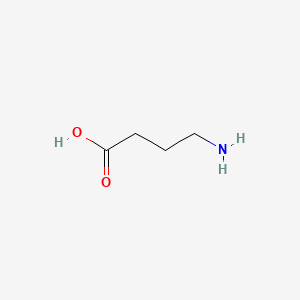4-aminobutyric acid
4-aminobutyric acid is a lipid of Fatty Acyls (FA) class. 4-aminobutyric acid is associated with abnormalities such as Epilepsy and Premenstrual syndrome. The involved functions are known as Binding (Molecular Function), neuron survival, Process, Uptake and physiological aspects. 4-aminobutyric acid often locates in Microglial, Neurofilament, Neuraxis, Brain region and Neurites. The associated genes with 4-aminobutyric acid are arginine methyl ester, SLC33A1 gene, NKS1 gene, P4HTM gene and ITSN2 gene. The related lipids are pregnenolone sulfate, pregnane-20-one, Pregnanes, Steroids and endogenous steroids.
Cross Reference
Introduction
To understand associated biological information of 4-aminobutyric acid, we collected biological information of abnormalities, associated pathways, cellular/molecular locations, biological functions, related genes/proteins, lipids and common seen animal/experimental models with organized paragraphs from literatures.
What diseases are associated with 4-aminobutyric acid?
4-aminobutyric acid is suspected in Premenstrual syndrome, Epilepsy and other diseases in descending order of the highest number of associated sentences.
Related references are mostly published in these journals:
| Disease | Cross reference | Weighted score | Related literature |
|---|
Possible diseases from mapped MeSH terms on references
We collected disease MeSH terms mapped to the references associated with 4-aminobutyric acid
PubChem Associated disorders and diseases
What pathways are associated with 4-aminobutyric acid
There are no associated biomedical information in the current reference collection.
PubChem Biomolecular Interactions and Pathways
Link to PubChem Biomolecular Interactions and PathwaysWhat cellular locations are associated with 4-aminobutyric acid?
Visualization in cellular structure
Associated locations are in red color. Not associated locations are in black.
Related references are published most in these journals:
| Location | Cross reference | Weighted score | Related literatures |
|---|
What functions are associated with 4-aminobutyric acid?
Related references are published most in these journals:
| Function | Cross reference | Weighted score | Related literatures |
|---|
What lipids are associated with 4-aminobutyric acid?
Related references are published most in these journals:
| Lipid concept | Cross reference | Weighted score | Related literatures |
|---|
What genes are associated with 4-aminobutyric acid?
Related references are published most in these journals:
| Gene | Cross reference | Weighted score | Related literatures |
|---|
What common seen animal models are associated with 4-aminobutyric acid?
There are no associated biomedical information in the current reference collection.
NCBI Entrez Crosslinks
All references with 4-aminobutyric acid
Download all related citations| Authors | Title | Published | Journal | PubMed Link |
|---|---|---|---|---|
| Summa M et al. | Presynaptic mGlu7 receptors control GABA release in mouse hippocampus. | 2013 | Neuropharmacology | pmid:22564442 |
| de Souza LM and Franci CR | Differential immunoreactivity of glucocorticoid receptor and GABA in GABAergic afferents to parvocellular neurons in the paraventricular nucleus. | 2013 | Neurosci. Lett. | pmid:23276637 |
| Anneken JH et al. | MDMA increases glutamate release and reduces parvalbumin-positive GABAergic cells in the dorsal hippocampus of the rat: role of cyclooxygenase. | 2013 | J Neuroimmune Pharmacol | pmid:23179355 |
| Egashira N et al. | Effects of mood stabilizers on marble-burying behavior in mice: involvement of GABAergic system. | 2013 | Psychopharmacology (Berl.) | pmid:23086022 |
| Han B et al. | Quantitative LC-MS/MS analysis of arachidonoyl amino acids in mouse brain with treatment of FAAH inhibitor. | 2013 | Anal. Biochem. | pmid:23044255 |
| Rajak H et al. | Novel limonene and citral based 2,5-disubstituted-1,3,4-oxadiazoles: a natural product coupled approach to semicarbazones for antiepileptic activity. | 2013 | Bioorg. Med. Chem. Lett. | pmid:23265873 |
| Shamsi Meymandi M and Keyhanfar F | Relative potency of pregabalin, gabapentin, and morphine in a mouse model of visceral pain. | 2013 | Can J Anaesth | pmid:23132044 |
| Anderson W et al. | Investigation of the anxiolytic effects of naringenin, a component of Mentha aquatica, in the male Sprague-Dawley rat. | 2012 Jan-Feb | Holist Nurs Pract | pmid:22157509 |
| Reese EA et al. | Gabapentin's minimal action on markers of rat brain arachidonic acid metabolism agrees with its inefficacy against bipolar disorder. | 2012 Aug-Sep | Prostaglandins Leukot. Essent. Fatty Acids | pmid:22841517 |
| Arapitsas P et al. | A metabolomic approach to the study of wine micro-oxygenation. | 2012 | PLoS ONE | pmid:22662221 |
| King AM et al. | 4-aminopyridine toxicity: a case report and review of the literature. | 2012 | J Med Toxicol | pmid:22782458 |
| Khan I et al. | Hemichorea-hemiballismus as the presenting manifestation of nonketotic hyperglycemia in an adolescent with undiagnosed type 2 diabetes mellitus. | 2012 | Indian J Endocrinol Metab | pmid:22701838 |
| Camp BW et al. | High serum androstenedione levels correlate with impaired memory in the surgically menopausal rat: a replication and new findings. | 2012 | Eur. J. Neurosci. | pmid:22758646 |
| Kamal SM | Combination of valproate and paroxetine in mice exposed to picrotoxin. | 2012 | Int J Nanomedicine | pmid:22679369 |
| Nakashima T et al. | [A case of paclitaxel-induced peripheral neuropathy successfully treated with pregabalin]. | 2012 | Gan To Kagaku Ryoho | pmid:22996788 |
| Rueda N et al. | Mouse models of Down syndrome as a tool to unravel the causes of mental disabilities. | 2012 | Neural Plast. | pmid:22685678 |
| Sotoing Taïwe G et al. | Antipsychotic and sedative effects of the leaf extract of Crassocephalum bauchiense (Hutch.) Milne-Redh (Asteraceae) in rodents. | 2012 | J Ethnopharmacol | pmid:22750453 |
| Chaparro LE et al. | Combination pharmacotherapy for the treatment of neuropathic pain in adults. | 2012 | Cochrane Database Syst Rev | pmid:22786518 |
| Newman EL et al. | Cholinergic modulation of cognitive processing: insights drawn from computational models. | 2012 | Front Behav Neurosci | pmid:22707936 |
| Ryu CH et al. | Valproic acid downregulates the expression of MGMT and sensitizes temozolomide-resistant glioma cells. | 2012 | J. Biomed. Biotechnol. | pmid:22701311 |
